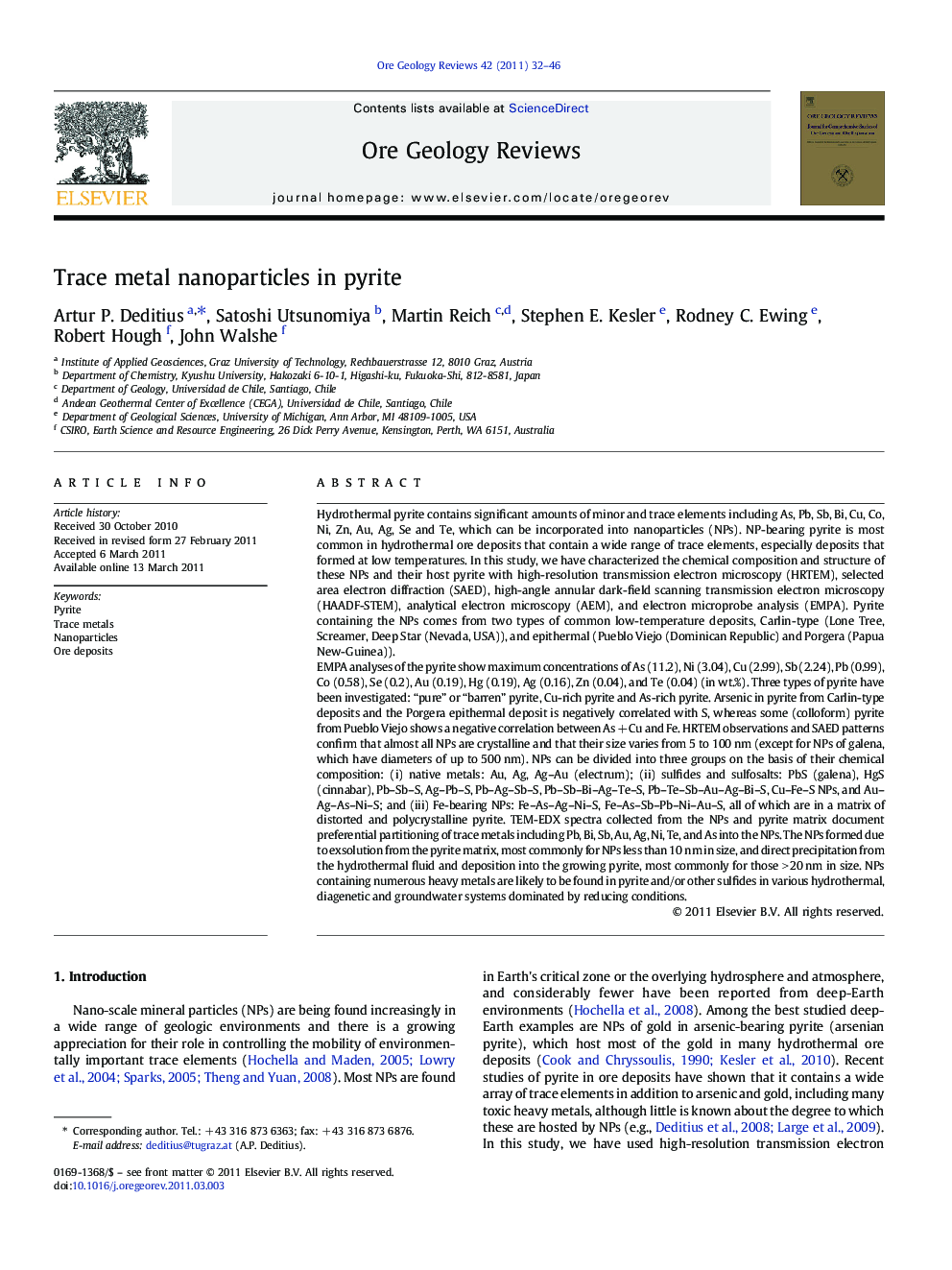| کد مقاله | کد نشریه | سال انتشار | مقاله انگلیسی | نسخه تمام متن |
|---|---|---|---|---|
| 4697699 | 1351894 | 2011 | 15 صفحه PDF | دانلود رایگان |

Hydrothermal pyrite contains significant amounts of minor and trace elements including As, Pb, Sb, Bi, Cu, Co, Ni, Zn, Au, Ag, Se and Te, which can be incorporated into nanoparticles (NPs). NP-bearing pyrite is most common in hydrothermal ore deposits that contain a wide range of trace elements, especially deposits that formed at low temperatures. In this study, we have characterized the chemical composition and structure of these NPs and their host pyrite with high-resolution transmission electron microscopy (HRTEM), selected area electron diffraction (SAED), high-angle annular dark-field scanning transmission electron microscopy (HAADF-STEM), analytical electron microscopy (AEM), and electron microprobe analysis (EMPA). Pyrite containing the NPs comes from two types of common low-temperature deposits, Carlin-type (Lone Tree, Screamer, Deep Star (Nevada, USA)), and epithermal (Pueblo Viejo (Dominican Republic) and Porgera (Papua New-Guinea)).EMPA analyses of the pyrite show maximum concentrations of As (11.2), Ni (3.04), Cu (2.99), Sb (2.24), Pb (0.99), Co (0.58), Se (0.2), Au (0.19), Hg (0.19), Ag (0.16), Zn (0.04), and Te (0.04) (in wt.%). Three types of pyrite have been investigated: “pure” or “barren” pyrite, Cu-rich pyrite and As-rich pyrite. Arsenic in pyrite from Carlin-type deposits and the Porgera epithermal deposit is negatively correlated with S, whereas some (colloform) pyrite from Pueblo Viejo shows a negative correlation between As + Cu and Fe. HRTEM observations and SAED patterns confirm that almost all NPs are crystalline and that their size varies from 5 to 100 nm (except for NPs of galena, which have diameters of up to 500 nm). NPs can be divided into three groups on the basis of their chemical composition: (i) native metals: Au, Ag, Ag–Au (electrum); (ii) sulfides and sulfosalts: PbS (galena), HgS (cinnabar), Pb–Sb–S, Ag–Pb–S, Pb–Ag–Sb–S, Pb–Sb–Bi–Ag–Te–S, Pb–Te–Sb–Au–Ag–Bi–S, Cu–Fe–S NPs, and Au–Ag–As–Ni–S; and (iii) Fe-bearing NPs: Fe–As–Ag–Ni–S, Fe–As–Sb–Pb–Ni–Au–S, all of which are in a matrix of distorted and polycrystalline pyrite. TEM-EDX spectra collected from the NPs and pyrite matrix document preferential partitioning of trace metals including Pb, Bi, Sb, Au, Ag, Ni, Te, and As into the NPs. The NPs formed due to exsolution from the pyrite matrix, most commonly for NPs less than 10 nm in size, and direct precipitation from the hydrothermal fluid and deposition into the growing pyrite, most commonly for those > 20 nm in size. NPs containing numerous heavy metals are likely to be found in pyrite and/or other sulfides in various hydrothermal, diagenetic and groundwater systems dominated by reducing conditions.
Research highlights
► Characterization of trace-element nanoparticles in pyrite from various ore deposits.
► Partitioning of trace elements between nanoparticles and pyrite matrix established.
► First report of Fe-bearing nanoparticles in pyrite.
► Demonstration of nanostructure and nanochemistry control on metal uptake into pyrite.
Journal: Ore Geology Reviews - Volume 42, Issue 1, November 2011, Pages 32–46